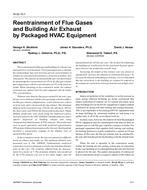Description
The reentrainment of flue gas and building air exhaust was measured on a roof-mounted, 10-ton packaged unit to identify the relationships that exist between percent reentrainment of exhaust air and separation distances, direction of airflow, and wind speed. The amount of entrained flue gas was determined by measuring the concentration of CO2 in the flue gas exhaust and comparing it with the concentration of CO2 in the fresh air intake. When operating in the economizer mode, the exhaust airstream was spiked with CO2 and compared with the intake CO2 concentration.
Dilution ratio data for flue gases emitted by the unit’s gas furnace were obtained with the unit operating with three different flue gas exhaust configurations:a tall vertical vent, a short vertical vent, and a downward-facing exhaust.The minimum dilution ratios measured were 1284 for the tall stack, 368 for the short stack,and 290 for the downward-facing stack. Plume dilution predictions were made using the analytical expressions presented in the 1997 ASHRAE Fundamentals for atmospheric dispersion of building exhaust and using computational fluid dynamic (CFD)analysis. The predictions were in good agreement, and both predicted approximately 50% greater dilution than measured for this unit. Both methods provided a conservative estimate of the dilution ratio of entrained flue gases.
In the economizer mode, the unit was operated at different levels of exhaust and intake air. The minimum dilution ratio measured was 9. The ASHRAE Fundamentals analytical expressions were not adequate to predict the minimum dilution ratio in this case. The estimates differed from the measurements by a factor of 5. The minimum dilution ratio predicted by the CFD analysis was two to five times higher than the measurements for all but one case. The method of exhausting the building air is believed to be the reason for the poor agreement between the predictions and the data.
Increasing the height of the exhaust vent was shown to significantly increase the dilution of entrained flue gases. To increase the dilution of building air exhaust, it is recommended that the restrictions to the building air exhaust be reduced so the exhaust air can be directed away from the unit at high velocity.
Units: Dual
Citation: Symposium, ASHRAE Transactions, vol. 108, pt. 2
Product Details
- Published:
- 2002
- Number of Pages:
- 12
- File Size:
- 1 file , 4.2 MB
- Product Code(s):
- D-8997




